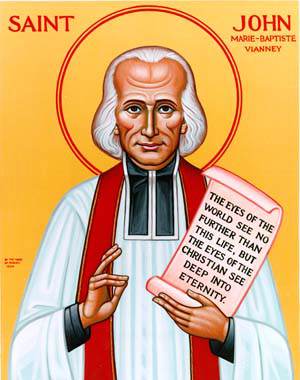 Toward the end of St. John Vianney’s life, as pilgrims flocked to Ars from all over France, they would leave marveling not only about having witnessed “God in a man,” as one contemporary described Vianney, but “God in a parish.” They were amazed at the warm hospitality, radiant faith and ardent charity of the people of the village, who would routinely open their homes to the overflow guests, welcome them as if they were Christ, feed them, encourage them in the Christian life, pray with and for them, and in short, love them as a Christian should. Because many of the pilgrims had to wait over a week for five minutes with the Curé of Ars in the confessional, it was this much lengthier contact with the Christians of Ars that would generally prepare these pilgrims for true and deep conversion: they witnessed in the ordinary people of Ars the type of faith to which they recognized that they, too, were called.
Toward the end of St. John Vianney’s life, as pilgrims flocked to Ars from all over France, they would leave marveling not only about having witnessed “God in a man,” as one contemporary described Vianney, but “God in a parish.” They were amazed at the warm hospitality, radiant faith and ardent charity of the people of the village, who would routinely open their homes to the overflow guests, welcome them as if they were Christ, feed them, encourage them in the Christian life, pray with and for them, and in short, love them as a Christian should. Because many of the pilgrims had to wait over a week for five minutes with the Curé of Ars in the confessional, it was this much lengthier contact with the Christians of Ars that would generally prepare these pilgrims for true and deep conversion: they witnessed in the ordinary people of Ars the type of faith to which they recognized that they, too, were called.
The transformation of the people of Ars can be called their Curé’s greatest miracle. When he was assigned as parish priest in 1818, Fr. Courbon, the vicar general, laconically informed him, “There is not much love for God there. You must put some.” Few were practicing the faith with any type of regularity, not to mention fervor. More people went to the taverns on the Lord’s Day than to Church. Blasphemy was rampant. Only a handful families prayed. The young were substituting lust for love. The state of catechetical formation was abysmal, due not just to the indoctrination of the French Revolution and a paucity of able catechists, but also to a general lack of interest among the villagers.
They were a case study in the first three types of soil Jesus mentioned in his Parable of the Sower and the Seed: there were several leading villagers with impenetrable soil who thought they already had all the important answers; there were others with rocky soil, who were superficially open to God’s message but who lacked the virtue to persevere in allowing the transformative seeds to grow; the majority seemed to have thorny soil, where worldly cares and anxieties — from work to the hunger for human respect — constantly choked the growth of God’s word within them. Very few had soil that would much fruit at all, not to mention the 30, 60 or 100 fold the Lord described.
It took St. John Vianney decades to till the soil of those in the village. Even though there were only sixty families and 230 people upon his arrival, it took him eight years to get most of the families of the village to return to Mass, 25 years to eradicate the taverns, and 29 years to eliminate the debauched dances called the vogues. Once he had eliminated these rocks and thorns from the village soil, however, he needed still more time truly to form them in Christian virtue so that they could bear fruit in abundance. Not only is all of this a testament to Fr. Vianney’s pastoral perseverance, but it is also a palpable example of the importance of priestly stability in assignments. The transformation of Ars from a place where there was “no love for God” to one that radiated piety and charity literally took decades — and likely occurred only because St. John Vianney was pastor there for 41 years.
Priestly stability is something that, during this Year for Priests [just concluded], the whole Church needs to ponder anew. For priests to be pastorally effective in being the Lord’s instrument to sanctify and save his people, it’s not enough that they be contagiously holy themselves. They also need time. If a priest as holy as St. John Vianney needed several decades to transform the people of a tiny parish in a simpler era, how much more time will priests who are not as zealous as the Curé of Ars need to transform much larger parishes in a more complicated one?
Pastoral stability has always been viewed by the Church as a positive good, for both priest and parishioners. The Second Vatican Council says that the “good of souls demands” pastoral stability and Church law enshrines it. “It is necessary that a parish priest [pastor] have the benefit of stability. Therefore, he is to be named for an indefinite period of time,” Canon 522 states. Under certain conditions, the Church allows dioceses to set terms for pastors, but specifies that the minimal term should be a renewable six years. In the Diocese of Fall River, there are no terms and pastors are appointed indefinitely.
At a functional level, pastoral stability allows the parish priest time to accomplish his essential tasks. In order to be an effective teacher, sanctifier and leader of his people, the pastor obviously needs to get to know his flock, and this takes time. As priests get fewer and the tasks for which they are responsible become greater, even more time is needed. In a small-to-midsize parish of 500 families, if a pastor were to carve out from among parish meetings and marriage, baptismal and counseling appointments one night a week to make home visits, it would take him ten years to visit every household once. In the past, pastors had the ability to do this, because they remained in their assignments for decades and were generally assisted by several other priests. They got to know families over three or four generations and the people got to know them in return. They had time to inaugurate and bring to maturity schools and other pastoral programs. They were able to get to know well the pastoral lay of the land, to begin initiatives to improve their neighborhoods and care for the needy, to develop friendships and good working relationships with civic leaders, to become known and respected by Catholics and non-Catholics alike, so that they could effectively collaborate with community leaders to address various problems that arose. Pastors are weaker today in most of these areas because they are not as secure in their assignments.
Pastoral stability is even more important at a theological and ecclesiological level. The pastor is meant to be in his parish a “quasi-sacrament” of Christ’s own relationship to his bride the Church: a committed presence who lays down his life for his bride and not just a transient figure. The priest is called “father” because he is supposed to be true spiritual father to his people, not an ephemeral spiritual guide. Real dads worthy of the name are not a presence just for five or ten years in their families’ lives before they leave and mom brings home another “dad.” When priests do not have true stability, the familial bond between priest and people the Church envisions never has a chance to develop because parishioners are reluctant to invest the time to form deep bonds with those whom they fear are only around temporarily. The priest, moreover, is supposed to be a sign and agent of unity in a parish community and a pastor cannot fulfill this responsibility without stability; if pastors are routinely transferred every five or ten years, the result is that they can begin to function and be viewed like stewards of ecclesiastical goods, or branch managers of Catholic Church, Inc. The source of unity and stability in parish life, rather than the priest, often becomes the parish staff.
During this [past] Year for Priests, this discussion of priestly stability was very timely because in many places priestly transfers, rather than priestly stability, are looked upon at the practical level as the positive good. Pastors are being transferred not just when another pastor retires, takes ill, defects or dies — as they always have been — but as a routine matter of course in what can sometimes seem like an annual ecclesiastical game of musical chairs. There are, clearly, some advantages to regular transfers: as in any “profession,” it can provide new challenges, prevent loss of zeal and personal or organizational stagnation, and enable convenient exits from inconvenient situations. But, as mentioned above, there are also clear disadvantages, at a theological and practical level, and that’s why priestly stability, rather than regular transfers, is enshrined in canon law.
Not every priest is St. John Vianney and not every priest, if left in place for 41 years, would help to make his people saints. But if priests at a practical level do not enjoy true stability in their office, not even priests as holy and zealous as St. John Vianney will have the time to sanctify their people.












